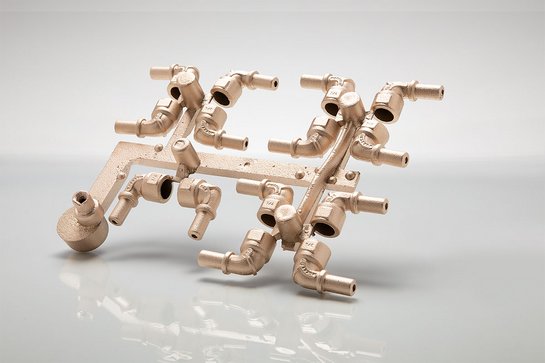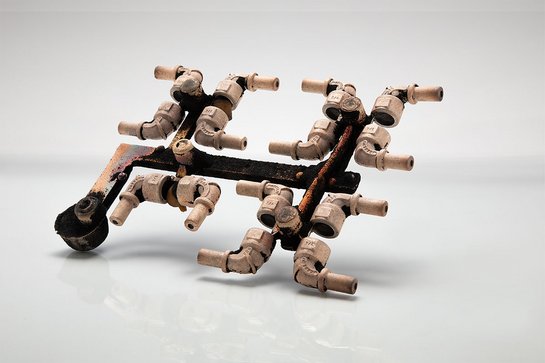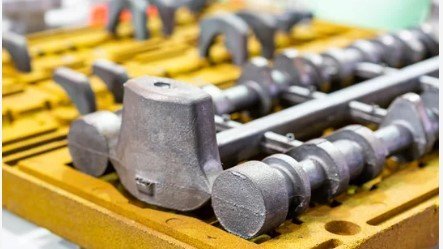
Forge & Foundry, Part 4 – Selecting a Shot Blast Machine for Sand Castings
, A.Altmann - Назад к обзору
Building upon the information shared in our last Forge and Foundry Series post about sand casting, we now turn to the process of selecting and designing machines to specific sand casting operations.
Selecting the right shot blasting machine for your process and work piece means understanding how the work pieces and machine will interact. Here are common questions Rösler receives when developing perfectly specified solutions for sand casting.
How do work piece delicacy, size, and weight influence the machine choice?


Before choosing a machine, the following questions must be asked:
- Are the parts sturdy, allowing for aggressive processing, or must they be handled gently, without any part-on-part contact?
- Is batch processing possible or must it be continuous?
- Which work piece handling system is best: rotary drum, troughed belt, wire mesh belt, overhead monorail system, or heavy-duty crane or trolley on rails for extremely heavy work pieces weighing several tons?
- Can the work pieces be handled by robot or is a custom-engineered shot blast system the best solution?
- How can coarse contaminants like sand lumps, broken off sprews, gates, risers, rebar, etc. be discharged from the shot blast system?
Rösler offers you a customized system that is perfectly configured to the characteristics of the workpiece and its processing!
Why is it so critical to remove loose molding and core sand from the media and how can this be done?
Sand is extremely abrasive. Even a small amount of sand (0.5-1 percent) in the media will lead to faster wear of the turbines and the blast machine. There are known cases where, due to a poorly functioning media cleaning system, the throwing blades had to be replaced every eight hours!
For this reason, blasting systems that work with more than six percent sand in the media must be equipped with a combined dual or triple drum magnetic separator for the safe removal of sand in the blast media and an air separator taking out any remaining sand, broken down media, and dust.
How can coarse impurities such as lumps of sand, sprues, flakes and foreign bodies be removed from the blasting system?
The starting point for blast media preparation is the vibratory screen conveyor. This is where casting and molding sand as well as larger fragments from the casting molds or foreign objects are sorted out and removed. Specially developed unbalanced motors ensure a continuous forward movement of the media/foreign body mixture. We adapt the technical design, size and conveying capacity of the vibratory screen conveyor to individual customer requirements. The coarsely cleaned media-sand mixture is then conveyed via the bucket elevator to the discharge box and a cross conveyor screw into the magnetic separator.
Conserving resources through efficient media processing
The magnetic separator is the actual heart of the media processing system. It separates the metallic shot blasting media from blasted foreign bodies and has various outlets for media, dust and sand. Separation takes place in two stages, or in three stages for difficult applications, or using two to three magnetic separators with north/south aligned neodymium magnets. In this way, highly efficient media processing is possible with an extremely low sand content in the blasting media or media content in the sand, which is around 0.02 percent by weight in each case.
Selection of the blasting system with the help of digital representation
Using the latest simulation software, we can visualize all relevant physical processes of the shot blasting process as well as the workpieces to be processed in 3D. These virtual models significantly shorten the design time and ensure faster system availability. In extreme cases, time savings of up to 12 months can be achieved with the help of digital pre-planning. Particularly interesting when using the blasting systems in everyday foundry work: the data generated during the so-called particle simulation enables precise statements to be made about the amount of blasting media required, the energy with which it must hit the workpiece surfaces and where and how much blasting media bounces off in the blasting chamber.
How can blasting systems for foundry applications be protected from premature wear?
Tiny amounts of sand in the media, scale and rust from the raw castings and the use of granular blasting media or large steel grit create a highly abrasive environment for the shot blast machine and turbines. Special precautions must be taken to prevent premature wear.
For example, the interior of the blasting chamber should be lined with manganese steel wear protection plates. We offer these as standard for all blasting systems in a thickness of 10 mm. We even offer special wear protection plates for foundry operations with a thickness of 25 mm. They are attached in the middle of the direct blasting area of the system using the innovative roof tile principle and are easy to turn and replace. As a rule of thumb, the better the combination of turbine alignment and wear protection package, the longer the service life of the machine.


